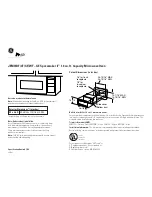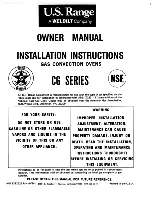
EXPERT COOKING GUIDE
Page 36
ROASTING AND GRILLING
ABOUT THE TABLES
The temperature and roasting time depend on the
type and amount of food being cooked. This is why
temperature ranges are given in the tables. Begin
with the lower temperature and, if necessary, use
a higher setting the next time.
For more information, see the section entitled Tips
for grilling and roasting which follows the tables.
OVENWARE
You may use any heat resistant ovenware
which is suitable for use in a microwave. Metal
roasting dishes are not suitable for roasting with
microwaves.
The ovenware can become very hot. Use oven
gloves to take the ovenware out of the oven.
Place hot glass ovenware on a dry kitchen towel
after they have been removed from the oven. The
glass could crack if placed on a cold or wet surface.
TIPS FOR ROASTING
NOTES
• Use a deep roasting dish for roasting meat
and poultry.
• Check that your ovenware fits in the cooking
compartment. It should not be too big.
• Meat: Cover approx. two thirds of the ovenware
base with liquid. Add slightly more liquid for pot
roasts. Turn the pieces of meat halfway through
the cooking time. When the roast is ready, turn
off the oven and allow it to rest for an additional
10 minutes. This allows better distribution of the
meat juices.
• Poultry: Turn the pieces of meat after ⅔ of the
cooking time has elapsed.
TIPS FOR GRILLING
NOTES
• Always keep the oven door closed when grilling
and do not preheat.
• As far as possible, the pieces of food you are
grilling should be of equal thickness. Steaks
should be at least 2 to 3 cm thick. This will allow
them to brown evenly and remain succulent and
juicy. Do not add salt to steaks until they have
been grilled.
• Use tongs to turn the pieces of food you are
grilling. If you pierce the meat with a fork, the
juices will run out and it will become dry.
• Dark meat, e.g. beef, browns quicker than lighter.
coloured meat such as veal or pork. When grilling
light-coloured meat or fish, these often only
brown slightly on the surface, although they are
cooked and juicy on the inside.
• The grill element switches off and on again
automatically. This is normal. The grill setting
determines how frequently this will happen.
BEEF
NOTES
• Turn pot-roasted beef after ⅓ and ⅔ of the
cooking time. Finally, allow to stand for approx.
a further 10 minutes.
• Turn tenderloins and sirloins halfway through
the cooking time. Finally, allow to stand for
approx. a further 10 minutes.
• Turn steaks after ⅔ of the cooking time.









































